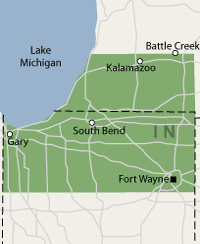
The Supportworks Helical Pier System
warrantied Push Piers For Stabilizing Failing Or Settling Foundations
What It Does:
Supportworks Push Piers are made of steel and include a set of helical blades on the lower section of the pier.
These piers are mechanically advanced into the soil using small construction equipment or hand equipment. As they are installed to appropriate depths and capacities, they prevent any future settlement issues. In many scenarios, these foundation piers will be able to lift your home back to level position by the completion of the installation.
Technical Features
- Year-Round Installation
- Warrantied for 25 Years
- Galvanized Steel Design Available
- Suitable For Both Heavy & Light Loads
- Does Not Rely on Weight of Structure For Depth & Capacity
- Round Shaft Has High Resistance To Bending
- Provides Opportunity to Attempt to Lift Foundation to Original Position
Our helical pier system is just what you need to stabilize your foundation! Call us for a free helical pier installation quote today!
We serve Gary, South Bend, Fort Wayne, and many nearby areas in Indiana.
How foundation helical pier systems work

(Left) A foundation helical pier design that meets ICC (International Code Criteria) standards, with a true helix shape.
(Right) A nonconforming blade, with more of a "duckbill" appearance. This makes it churn up and disturb the soil during installation.
Foundations will experience settlement issues when the soils below the house prove unable to support the weight of the structure. Helical pier systems create a solid supporting base that transfers the weight of your home downwards to strong supporting soils.
How Helical Piers Work
First, soil is removed from the area where the helical pier will be installed. Helical pier sections are mechanically "screwed", or advanced, into the soil.
Once proper depths and capacities are achieved, heavy duty steel foundation brackets are positioned below and against the foundation footing.
The weight of the home is then transferred through the helical piers to deep, competent soils. Lifting the home back towards its original position is attempted. Then, the soil around the foundation is carefully replaced.
Installing Helical Piers
The first section of the pier that is advanced into the ground has one or more helical blades (Or "bearing plates") welded to the shaft. Additional sections do not have bearing plates, and are instead used to extend the pier to the necessary installation depth.
Helical piers can be installed from either the exterior or interior of your home, providing an opportunity to lift your home back to its original position by the end of the installation time.
Helical piers can also be effective at closing cracks caused by settlement, as well as improving the operation of doors and windows.
More about Foundation Stabilization.
When To Use Foundation Helical Piers
With knowledge of local soil conditions, helical piers can be an ideal solution because the installing contractor will know exactly how deep to install the piers to reach a stable soil layer that can support your home. If your goals are the following, helical piers are a good choice:
- You need the best opportunity to lift your home back to its original position.
- Lighter structures, such as decks or stoops, are in need of stabilization.
- You'd like minimal disturbance during installation.
- You're looking for a fast, effective installation.
- Restoring your property value is a priority.
Once your helical piers have been installed, you can count on your problem to be solved -- once and for all!
Foundation Pier Application Chart |
|||||
| Removal & Replacement |
Concrete Underpinning |
Concrete Piers |
Helical Piers |
Push Piers |
|
| New Construction Of Home Or Addition |  |
||||
| Can Be Installed From Home's Interior |  |
 |
 |
||
| Installation Usually Completed In Less Than One Week |  |
 |
 |
||
| Lowest Risk When Local Soil Information Is Unknown |  |
||||
| Stabilize Light Structures Such As Decks Or Stoops |  |
 |
 |
||
| Limited Disturbance To Lawn & Landscaping |  |
 |
 |
||
| Solution Extends Past Troubled Soils |  |
 |
|||
| Permanently Stabilize Foundation Without Maintenance |  |
 |
|||
| Ability To Lift Home Back To Level |  |
 |
 |
||
Professional Helical Pier Installers In Indiana!
At Foundation Supportworks, Inc., we're proud of our permanent, warrantied solutions for foundation settlement of all types. Our team of professional contractors has repaired settling foundations throughout Indiana, and we're ready to help you.
If you would like a free foundation helical pier installation quote, call or e-mail us today! Each of our quotes comes at no obligation and includes an on-site inspection, free consultation, and a complimentary copy of our 90-page, color foundation repair book.
We're proud to serve South Bend, Fort Wayne, Gary, and all surrounding areas.
Browse Our Foundation Repair Products:
Looking for a price? Get a no cost, no obligation free estimate.















